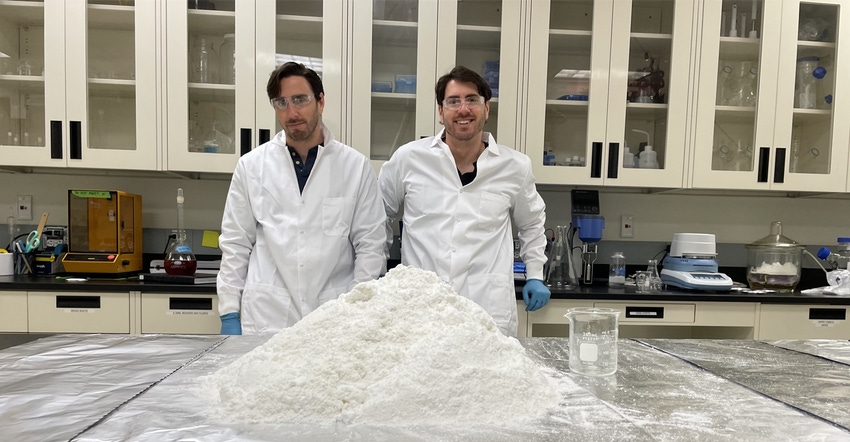Could PHA Bioplastics Market Gain on Petroleum-based Plastics?
California-based Full Cycle Bioplastics has developed a patent pending biotechnology that uses food waste, and co-founders and brothers Jeff and Dane Anderson say they can make product at a cost that’s competitive with virgin plastic derived from fossil fuel. At the same time, they can turn carbon into a circular commodity.

Demand for plastics is not going away, clearly seen by a market valued at $700 billion that’s projected to grow to a trillion by 2030. But the push for plastic-free alternatives, especially packaging, is not going away either, propelled by consumers and policy makers and as new reports pour out disclosing the environmental impact of the roughly 150 million tons of plastic trash floating in oceans. Packaging and consumer package goods manufacturers are clamoring to respond, weighing in on some of those alternatives, with one being PHA (polyhydroxyalkanoate), a bioplastic typically made of waste from starchy crops or food-grade oils.
But these feedstocks are not cheap to work with, so a handful of PHA platform developers are beginning to source other materials, believing they can make their business models pan out moneywise.
California-based Full Cycle Bioplastics is among them. It’s patent pending biotechnology uses food waste, and co-founders and brothers Jeff and Dane Anderson say they can make product at a cost that’s competitive with virgin plastic derived from fossil fuel. At the same time, they can turn carbon into a circular commodity. Plus, the PHA breaks down in the ocean and compost piles, which all PHAs claim to do, but the Anderson’s say theirs’ appears to biodegrade sooner than many.
Here's how their platform works:
It breaks down organic waste into volatile fatty acid liquid that is fed to the bacteria in organic waste, which create the PHA. The PHA is extracted from those bacteria, and it’s purified and pelletized.
“The economics are drastically different than with canola oil (most commonly used for PHA applications). Canola costs over $700 a ton, but we get paid to take generator’s unwanted organic waste – the material that serves as our feedstock,” Jeff says.
The brothers are focusing on co-locating with food waste facilities, mainly compost sites that screen the material then send it to Full Cycle to break it down into the fatty acid liquid. What does not break down stays with the composter for its stream.
“We take the liquid/moisture that comes out of the compost pile, but the compost itself (solid part) remains with the composter. In essence we take only what would have come off as CO2 and find a use for carbon that otherwise would have been wasted. Where canola producers use land and energy-intensive resources to farm canola, then press the seed oils. So, using organics is both lower cost and more sustainable,” Dane says.
The entrepreneurs’ vision is to get to $1 a pound, cheaper than using canola and in line with the cost of PLA (polylatctic acid plastic), typically made from corn, and currently the predominant bioplastic.
As far as its biodegradability in oceans—one of the most compelling claims of PHA producers—the rate at which it breaks down depends on the water’s temperature. Through their own lab work, the Andersons say they have seen complete degradation in a month, though anticipate the process would be slower in colder oceans.
Full Cycle does business with what it describes as large tech companies in the San Francisco Bay area to create barrier and non-barrier films for bags, food wrapping, and pallet wrapping among applications. And it’s working with Fashion for Good, which is an international industry group of fashion companies, to make a PHA fiber to replace polyester.
Currently the fairly young company (launched in 2014) is running a demo facility to continue its product development; a midscale production facility is slated for mid-2022; and plans are to commission a commercial-scale facility in early 2024.
Tech companies with their varied PHA versions hope to offer more than what its forerunner, PLA, currently can. PLA is more limited in its biodegradability. It does not compost quickly and consequently composters are pulling it from their streams.
But PLA can be blended with PHA to boost its performance, so developers of this next generation of bioplastics believe it may give PLA, and bioplastics, a lift.
“PHA is a better standalone polymer than PLA from a biodegradability standpoint. But it may also be a fix for the issues composters have seen with PLA [in other ways] in that blending the two may improve that PLA property, and it may improve compostability of those resins,” Dane says.
Meanwhile, the PHA market is growing, with many of the few innovators in this space doubling and tripling their production. Market signs are that it will overtake PLA as the predominant bioplastic, say some developers.
Dane’s projection about PHA specifically sourced from food waste: If it can be ramped up to achieve high capacity it will present “huge” opportunity and economic gains for the waste industry. “Organic waste will quickly be monetized at scale.”
Among the largest players in the PHA space are biotech companies Danimer Scientific (headquartered in Georgia) and Singapore- and U.S.-based RWDC, as well as Japanese manufacturer Kaneka. All three use food-grade oils and seem to be gaining some traction.
Still there are skeptics. They question the economics and scalability of PHA technology in general. Some questions claims around just how rapidly it biodegrades. And, overall, more research is needed, say those who take pause.
Ramani Narayan, a chemical engineer at Michigan State University, is cautiously optimistic. He says the biodegradability of PHA has at times been "oversold," though he notes it is one of the most biodegradable polymers on the market.
Narayan estimates that a bottle made from PHA that finds its way into the ocean would typically last several years before it thoroughly breaks down. Though he says, “It’s better than polyethylene and polypropylene, which will keep on accumulating."
Investment company Spruce Point Capital Management, who “bets” on companies’ stocks dropping, released a report about a year ago targeting Danimer, alleging that the corporation can’t deliver the product at the scale and cost it says it can due to the high cost of canola. At the time of the report, Danimer was running its PHA production at 66% capacity and only 10% of its planned production in Georgia was under contract, according to Spruce Point.
Danimer has since announced securing a $400,000 grant to evaluate high-oleic soybean oil to make PHA which it says is a “readily available” and “likely a viable and cost-effective” feedstock. And it stated with its recent acquisition of Novomer it expects to be able to produce variations on its PHA at a lower cost.
A few others are following suit, looking for cheaper ways to make PHA, mainly through different feedstocks.
NewLight Technologies makes PHA from ocean microorganisms that use air and carbon from greenhouse gases. The company, which recently commissioned a commercial-scale production facility in Southern California, makes regenerative foodware and fashion.
Ontario-based Genecis received a $6 million grant to create PHA from organic waste to incorporate in single-use packaging.
Mango Materials says it’s created a platform that allows it to make PHA pellets derived from plant materials and or methane.
The minds and money behind Full Cycle are anxious to see PHA gain more traction, and not just its own model.
“We route for everybody in the PHA space,” Jeff says commenting there is plenty of room for any developer with a working plan to help advance PHA.
“Collectively [developers] will allow bioplastics to take over a larger percentage of the total plastics market. And as it starts to take market share from petroleum-based plastics the PHA industry as a whole will profit.”
About the Author(s)
You May Also Like




